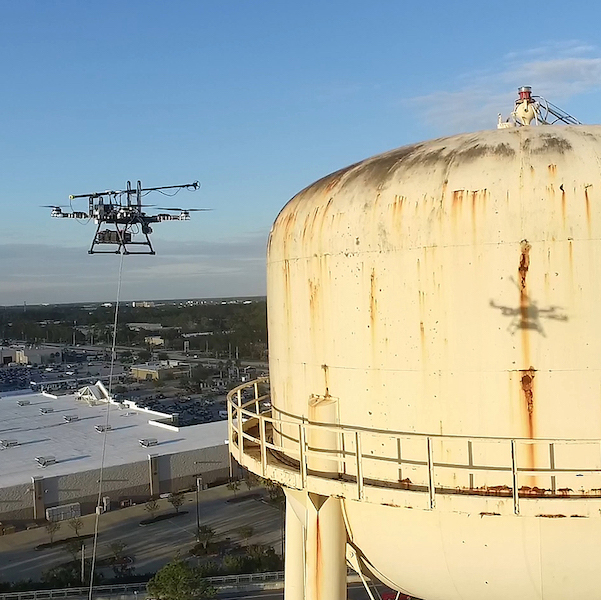Bob Dahlstrom was painting the exterior of his house one day when an idea came to him. Dahlstrom had spent his college summers painting and knew a thing or two about the dangers and inconveniences of this job.
“I kept thinking, ‘There has got to be a better way,’ as I was standing high on a ladder, looking down at the paint compressor, it just hit me. A drone should be doing this,” he said.
Dahlstrom envisioned a new type of drone, one that could perform tasks robotically. Dahlstrom created a new company, Apellix. The company created a custom-built drone to perform work, like cleaning, painting and testing, up in the air. WorkBoat sat down with Dahlstrom to find out about his journey from the ladder to founding a company that built spray painting drones. Dahlstrom is scheduled to speak at the International WorkBoat Show on Wednesday, Dec. 4, part of the Maintenance and Repair conference program.
WorkBoat: We are all familiar with drone aircraft used by the military for surveillance and warfighting, and commercial and recreational drones used for things like aerial photography and land surveying. Why can’t that type of drone be used for painting your house or the house on an aircraft carrier?

Robert Dahlstrom
Dahlstrom: There are a few problems with using existing drone technology to do robotic tasks. First, drones like the ones you describe are basically aircraft, they rely on GPS for location information, what if you want to paint behind a ship’s hull that is blocking the satellite signal to the GPS? On a ship, the steel hull and structures throw off the magnetic compass, which the drone uses for directional navigation. Instead of seeing the drone as an aircraft flown remotely by an operator on the ground, Apellix drones are flying computers, with multi-modal sensor perception making micro-adjustments to the flight in fractions of milliseconds, rather than relying on a human operator. The computer is doing the flying.
WB: Is the drone powered by batteries or does it have an engine?
Dahlstrom: The Apellix drone is tethered to shore power. It can work for as long as needed without a break. Most industrial drones need a battery change every 15 minutes. The human operators of those drones need that as well, since remote flying requires an exhausting level of concentration. The Apellix drone flies itself and performs its work with direction, but it has its own brain, so to speak.
WB: What sort of tasks can the Apellix drone perform?
Dahlstrom: Our current drone performs non-destructive testing more efficiently than a human in places that are difficult or dangerous to reach. The drone is fitted with a device to perform dry film thickness testing on painted surfaces. Or it can take UT measurements to test thickness of steel. It can even be used to test the integrity of rebar within a concrete structure, such as a bridge. Our drones will ultimately be capable of surface cleaning, preparation and painting. These systems are under development.
WB: Can you provide an example of where these drones are used?
Dahlstrom: In the oil and gas industry, there are lots of above-ground storage tanks. Regulations require testing the tanks’ thickness and protective coatings regularly. Before Apellix, the only way to perform these tests on the sides and tops of these tanks, which are very large, was for a person to either get in a man-lift or cherry-picker or climb up the side and rappel down. It is dangerous work. It might take several days to get the requisite number of measurements. But the drone can fly up, take several hundred measurements and fly back down before lunch. Also, the drone collects and archives data all along the way, providing a record of the inspection that is far more in-depth than a human surveyor’s.
WB: Is the instrumentation delicate? Can the drone work in different environments?
Dahlstrom: One of our recent projects was to do testing on the 100-meter flare stack at an oil and gas refinery. This type of stack burns off emissions. The drone was able to fly up and take measurements while the refinery was in operation and can even do its work if the surface temperature is 200 degrees or hotter. To inspect with a human, the plant would have had to shut down for several days while scaffolding was erected and testing performed. The robot doesn’t care if its 200 degrees. The industrial drone doesn’t care either. We also were able to provide the stack’s owner with information from the stack in real time during operations. The drone is equipped with a cellular modem to transmit an auditable record.
WB: So, is the drone painting your house yet?
Dahlstrom: Not quite yet, but eventually. We have partnered with the largest paint manufacturer in the world, International Paints (AkzoNobel) as part of a joint development agreement to create our upcoming painting drone. This will be a true revolution in coatings application. For example, formulae that are not safe for humans to apply such as those with nanoparticles to prevent microbial growth that accounts for much of the degradation of paint can be applied with the drone in the air and the operator safe on the ground. The robot drone is fine with them. As for other applications, we are working on robotic cleaning of surfaces so we can prep, paint and verify the efficacy of the coating with DFT readings. The drone works with the efficiency of a factory robot while keeping the human operator out of harm’s way. In terms of applications, the sky’s the limit.




